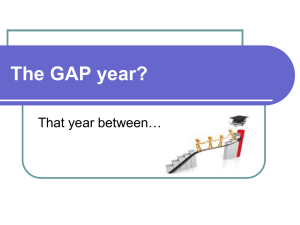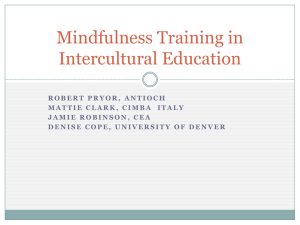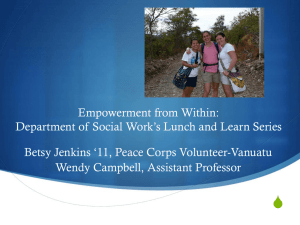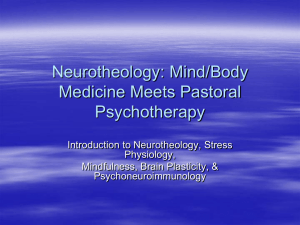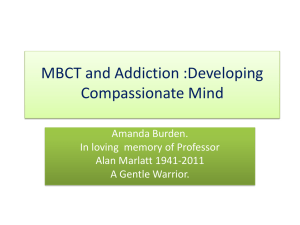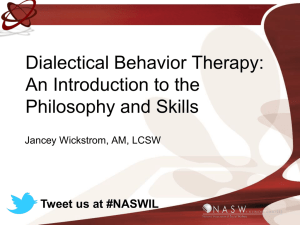Presentation - CEA Study Abroad
advertisement
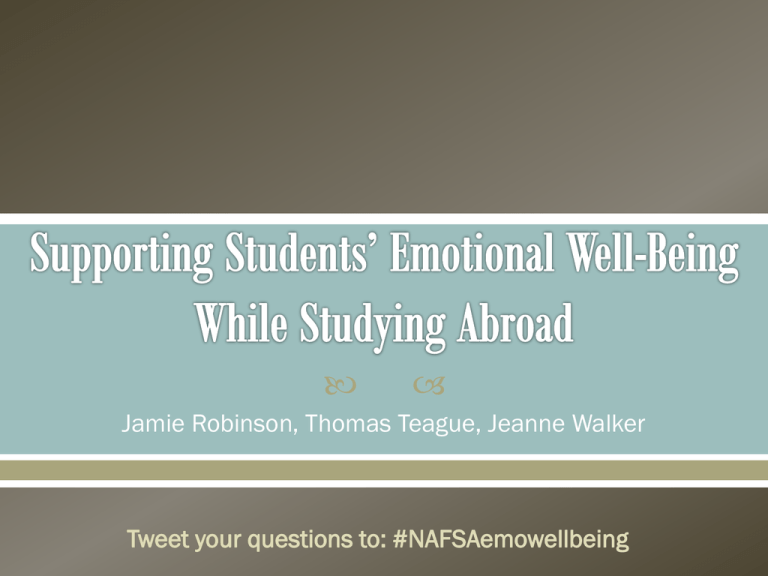
Jamie Robinson, Thomas Teague, Jeanne Walker Tweet your questions to: #NAFSAemowellbeing Issues of mental health and safety remain at the forefront as more students participate in education abroad. Students need to be prepared and supported for these experiences. Promoting mental health and safety to support emotional well-being: o Pre-departure screening – Psychological pre-planning o Best practices across the field o Experiential mindfulness exercise Jamie Robinson, LMFT, RDT o Mental Health Advisor, CEA o Primary Clinician, University of California, San Francisco Thomas Teague o Education Abroad Advisor, University of Kentucky Jeanne Walker, PhD o Director, Student Psychological Counseling Services o Chapman University Tweet your questions to: #NAFSAemowellbeing Students with Mental Illness All students indicating psychiatric disorders or taking medication should be contacted. Information is needed to best support accommodations for students. This approach promotes student disclosure. Emphasis will be placed on the Pre-Departure and While Abroad phases Anxiety Depression: clinical, mild, major Obsessive Compulsive Disorder Attention Deficit Hyperactivity Disorder Eating Disorders Bipolar Disorder Post Traumatic Stress Disorder 1. Assess for safety 2. Assess for accommodations/needs 3. Assess for students’ capacity to manage symptoms To help students consolidate their strengths and resources before going. NOT our goals: 1. Fix a student 2. Cure a student 3. Analyze a student 4. Pathologize a student 5. Diagnose a student Identifying the current impact of symptoms on the student's life. o "How is depression affecting you right now in your life?“ o What are your depressive or anxiety symptoms? o What led to your hospitalization? o What is the impact of depression on your day to day life now? o How has depression or anxiety affected your life recently? What triggers your symptoms or episodes? o Important for Bipolar, Panic Attacks, Eating Disorders, OCD Who, what, and where is important in maintaining the student’s well-being? What do you do to calm down, feel safe, etc.? o Use the students’ language when they give you words Who do you talk to or spend time with? Where do you feel safe? Who do you tell about these symptoms? Are you currently in contact with any treatment providers? Have you considered making a plan for coping with these symptoms? Who would you talk to about making a plan? Specific items for the plan include: o o o o o o contact with a known treatment provider ways to cope with triggers housing sleep, eating, roommates, academics communication with international staff about symptoms access to treatment abroad YOU DON’T HAVE TO MAKE THE PLAN WITH THE STUDENT Student Reflections & Strategies “You can look at pictures and such, but nothing will be the same [when you] get there in person” “…I wish I had more time in-country to keep more of an emotion journal…Emotion is important in reflecting.” “It was really good for us to have conversations…with someone that you feel you can be open with…just being able to talk about it…and having someone to bounce your ideas off of and ask them for feedback. It’s amazing what some feedback can do.” “Sometimes it’s the students that have never undergone counseling or treatment that sometimes need the most support” Emphasized goal and expectations setting in pre-departure orientation o Gave examples; Encouraged developing & sharing of goals in-person Linked orientation sections, infused culture, and provided support resources (i.e. faculty, on-site staff, other contacts) Goals & Expectations Identity & Background Culture & Cultural Adjustment Health, Safety & Expectations Provided Pre-Departure and “While Abroad” handbooks, reflection questions Using different language, ways of thinking o e.g. Culture Shock; “U-curve model” Engaging students in activities to better understand themselves and their colleagues o Personality-type icebreaker; Assumptions activity Incorporating campus partners or past students Working with on-site partners and/or 3rd party providers Utilizing supervised grad students in Psychology to help support students while abroad– via Skype Mentor program on-site– each staff assigned to students Responses taken from a survey conducted via SECUSS-L in April 2014 If interested in obtaining full survey results, please email thomas.teague@uky.edu . Name your WAFs Talk to others Unanticipated WAFs CONTROL IS THE PROBLEM, NOT THE SOLUTION Mindfulness = observing and creating a wise mind “Mindfulness is not a special state you achieve through a trick or a technique. It is a way of being. Mindfulness is the awareness that emerges through paying attention on purpose, in the present moment, nonjudgmentally to things as they are”. ~ Jon Kabat-Zinn Mindfulness is: o Intentional– acting with awareness o Experiential– present moment focus o Non-Judgmental– observing self vs. judging self Awareness– Requires attention Separation– Impartial observer Compassionate witness– Acceptance Letting go and moving on– Self-regulation tools Examples: o HEAL o WAF Busters o ACT o Wheel of Awareness Have a positive experience Enrich it Absorb Link positive & negative material HARD WIRING HAPPINESS Rick Hanson Demoting the WAFs Physical exercise Moving meditation Teach breathing techniques Guided imagery Using humor Thoughts are just words Feeding the tiger Driving your life bus Get off your but(t)s THE MINDFULNESS & ACCEPTANCE WORKBOOK FOR ANXIETY (Forsyth & Eifert) THE MINDFUL BRAIN (Siegel) Breathe to Relax Buddify Calm Zen Meditative Music Tweet your questions to: #NAFSAemowellbeing NAFSA E-Book: Best Practices in Addressing Mental Health Issues Affecting Education Abroad Participants o www.valdosta.edu/academics/academic-affairs/international- programs/dept/documents/study-abroad/mental-health.pdf Moving with Emotional Resilience Between and Within Cultures (Janice Abarbanel, PhD) o www.afs60.de/webcontent/files/MbM_Abarbanel.pdf


